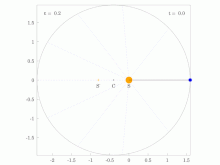Discussió:Lleis de Kepler
Corregeixo la tercera llei treient la referència a les unitats astronòmiques ja que la llei es compleix independentment de les unitats que es facin servir.--Pere prlpz 20:00, 24 nov 2006 (CET)
He corregit la llei de Kepler i he afegit una reformulació matemàtica de la 3a Llei de Kepler més ampliada. --62.57.176.118 (discussió) 09:28, 29 jul 2009 (CEST)
Traducció
[modifica]| Aquest article, o una part, prové d'una traducció de l'article sota llicència CC-BY-SA-3.0 i/o GFDL: «Kepler's laws of planetary motion» (anglès). Consulteu l'historial de la pàgina original per a conèixer la llista d'autors. |
--Townie (discussió) 16:23, 4 des 2018 (CET)
Animations demonstrating Kepler's Second Law of Planetary Motion.
[modifica]There is an animated figure on the English version of this page which I made which the shows motion of planets orbiting with various eccentricities around a star and may be of use.
The animated gifs are individually viewable at https://commons.wikimedia.org/wiki/File:Circular_orbit_of_planet_with_(eccentricty_of_0.0).gif https://commons.wikimedia.org/wiki/File:Ellipitical_orbit_of_planet_with_an_eccentricty_of_0.2.gif https://commons.wikimedia.org/wiki/File:Ellipitical_orbit_of_planet_with_an_eccentricty_of_0.5.gif https://commons.wikimedia.org/wiki/File:Ellipitical_orbit_of_planet_with_an_eccentricty_of_0.8.gif The code to produce the table is here (see edit mode):







